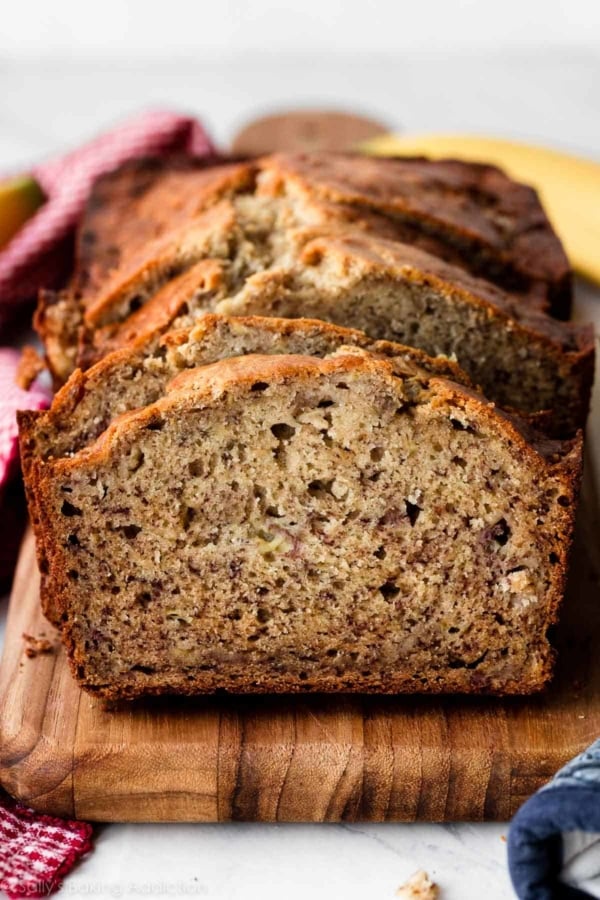Learn how to make an easy homemade buttermilk substitute for baking recipes, as well as what buttermilk does for baked goods, why it’s required in some baking recipes, and more about the unique properties of this curious ingredient. My team and I tested several substitutes including regular milk, DIY soured milk, sour cream, kefir, and powdered buttermilk.

Welcome back to my baking tips series. If you’ve ever wondered what certain ingredients do in baking, when to use them, and why, this is where I share what I’ve learned. Like what’s the difference between baking powder vs. baking soda, or Dutch-process vs. natural cocoa powder? Today we’re exploring the whats, whys, and hows of buttermilk.
What Is Buttermilk?
Buttermilk is fermented milk. Traditionally, it was a byproduct of making butter; the liquid leftover after churning fat out of cream was left out to ferment. Nowadays, the kind of buttermilk you can buy in the grocery store is made in a controlled environment by adding bacteria to milk, which produces lactic acid.
While I don’t exactly crave a tall glass of buttermilk to wash down my cookies, I often have it in my refrigerator because it’s a key ingredient in so many baking recipes.

What Does Buttermilk Do in Baking?
Buttermilk’s lactic acid, as well as its tangy flavor and creamy consistency, does so much for baked goods. The acid reacts with baking soda to produce carbon dioxide bubbles, which leaven the batter or dough, resulting in lighter, fluffier textures in biscuits, muffins, cakes, and buttermilk waffles.
Even low-fat buttermilk is thick and creamy, which contributes to a tender or flaky crumb and moist texture, even when baking soda isn’t present. Plus, it adds a subtle tangy flavor that enhances the overall taste of the finished baked good.
How to Make a Buttermilk Substitute
Because of buttermilk’s unique contributions to baking recipes, you shouldn’t simply substitute regular milk, especially if there is baking soda in the recipe.
Instead, you can make a homemade DIY buttermilk substitute or “DIY soured milk” by adding an acid—either white vinegar or lemon juice—to regular milk and letting it sit for a few minutes. This simple step only adds about 5 minutes to your baking prep time, and makes a BIG difference in your finished baked good. It’s a fine substitute in recipes that call for less than 1 cup of buttermilk.

You’ll find the instructions in the printable recipe card below, but here’s an overview of the process:
Add 2 teaspoons of white vinegar or lemon juice to a liquid measuring cup. Then add enough whole milk to the same measuring cup until it reaches 1 cup. Stir it around and let sit for 5 minutes. The homemade “buttermilk” will be somewhat soured and curdled and ready to use in the recipe.
Success Tip: I typically use low-fat buttermilk, which is plenty thick (there’s really no discernible difference between whole and low-fat buttermilk in the finished baked goods), but if you’re making this DIY buttermilk substitute, I strongly recommend using whole milk. Low-fat or nondairy milks work in a pinch, but your cakes/muffins/biscuits won’t taste as moist or rich. Avoid using nonfat milk.

Side-by-Side Comparisons
Baking science experiment time! To explore the difference buttermilk makes in the taste and texture of baked goods, and determine the best substitute to use if you don’t have any on hand, my team and I tested 3 different recipes, each made 4 times exactly the same way but with 1 ingredient change:
- Store-bought buttermilk (our “control”)
- DIY homemade buttermilk substitute (white vinegar + whole milk)
- Whole milk
- Powdered buttermilk + water
We tested these 4 ingredients in my recipes for cornbread muffins, strawberry shortcake biscuits, and no-yeast bread (soda bread).
Note: For the powdered buttermilk test recipes, we followed the package’s instructions, mixing the powder into the dry ingredients, and the water into the wet ingredients. The package didn’t mention mixing the powder with water first, which would have obviously helped dissolve the powdery chunks we tasted in some of these bakes.
Cornbread Muffins Test
First, let’s look at the cornbread muffins:

The whole milk muffins rose surprisingly high with a tall peak, and were a little more crumbly and dry. There wasn’t enough acid in this batter, so there was leftover baking soda that wasn’t neutralized, which left a slightly bitter aftertaste.
The real buttermilk muffins looked the way we expected and they tasted the best.
The powdered buttermilk muffins tasted sour—the flavor was definitely off. They also had a denser texture and didn’t rise as high.
The DIY buttermilk muffins yielded a similar result to the real buttermilk. They were great!


Shortcake Biscuits
Now let’s take a look at the shortcake biscuits:


The whole milk shortcake biscuits looked good, but were lacking flavor and tasted a bit flat.
The real buttermilk shortcake biscuits rose beautifully, with lots of flaky layers, and browned nicely on top.
The powdered buttermilk shortcake biscuits had chunks of orange-colored powder clumps, which didn’t dissolve properly. They also spread more, didn’t rise as high, and didn’t produce as many flaky layers.
The DIY buttermilk biscuits rose as high as the real buttermilk biscuits and had nice flaky layers; the flavor was good and these tasted most similar to the real buttermilk biscuits.
No Yeast Bread
Finally, let’s look at the recipe that calls for the most buttermilk, which is this no-yeast bread:

The whole milk no-yeast bread had an incredibly dense texture, bordering on “hard as a brick.” It was also lacking in the flavor department. This recipe NEEDS the acidity of buttermilk.
The buttermilk no-yeast bread came out nicely shaped and browned, with a dense yet moist texture, crusty exterior, and rich flavor as intended.
The powdered buttermilk no-yeast bread over-spread a significant amount, and once again the powder didn’t fully dissolve so there were visible chunks of it throughout. It also had a particularly sour flavor.
The DIY buttermilk no-yeast bread rose and browned nicely and tasted good. This is a naturally dense bread because the only leavening comes from the buttermilk’s acid + baking soda, but the crumb of this loaf was slightly denser than the one made with real buttermilk.
What About Using Sour Cream or Yogurt?
We went one step further in this test and tried the shortcake biscuits with a sour cream and whole milk combination to produce a DIY buttermilk substitution. This substitution can work most of the time. For every 1 cup of buttermilk, you can use 1/2 cup (120g) full fat sour cream or whole milk yogurt and 1/2 cup (120ml) whole milk.
But keep in mind that the results may not be the same compared to using real buttermilk.

In particular, with the shortcake biscuits, they weren’t as tangy and they had a fluffier, less flaky texture. They were still delicious—they just lacked the intended flavor and texture. In recipes where you want a fluffy, soft texture, you could easily use this sour cream/milk substitution instead of buttermilk.

What about using kefir instead of sour cream? I’ve used kefir as a 1:1 substitute for buttermilk in scones and cupcakes and it works very well. If you happen to have kefir and not buttermilk, you can absolutely use it. In fact, pastry chef Stella Parks has written that it’s one of her favorite buttermilk subs.
Can I Freeze Buttermilk?
Yes, you can freeze leftover buttermilk. Up to 3 months is ideal, and you can freeze it in smaller freezer bags such as these. Thaw in the refrigerator, then whisk to combine if it has separated.
In Conclusion
All the baked goods made with regular store-bought buttermilk had the best taste and texture. The DIY homemade buttermilk substitute came in second place. It gave the baked goods a similar texture and flavor and is my preferred alternative, but only if you can’t get your hands on the real thing. The sour cream/milk combination works too, but you’ll notice a cakier/fluffier texture (which isn’t a bad thing in some cakes, cupcakes, etc). Kefir can work as a 1:1 substitute if you have it on hand. Powdered buttermilk can work if you pre-mix it with water, but the flavor isn’t identical to the intended result. All in all, in baking recipes that require more than 1 cup of buttermilk, I strongly recommend using real buttermilk because using alternatives will likely compromise the flavor and texture.
How Can I Use Buttermilk?
Here are all of my recipes that call for buttermilk. The following are some of my very favorites:
- Chocolate Layer Cake
- Buttermilk Waffles
- Black Velvet Cupcakes
- Scones (you can sub 1:1 for heavy cream)
- Buttermilk Lavender Scones
- Zebra Cake
- Buttermilk Biscuits
- Strawberry Buttermilk Pancakes
- Berry Galette With Buttermilk Cornmeal Crust

DIY Buttermilk Substitute
- Prep Time: 5 minutes
- Total Time: 5 minutes
- Yield: 1 cup
- Category: Baking
- Method: Mixing
- Cuisine: American
Description
If you don’t have buttermilk on hand and need it for a baking recipe, use this easy method to make a DIY buttermilk “soured milk” substitute. This is a great substitution for buttermilk in most baking recipes. However, you’ll begin to notice a flavor and texture change in recipes that call for more than 1 cup of buttermilk. For best flavor and texture, I recommend using real buttermilk when you can.
Ingredients
- 2 teaspoons white vinegar or fresh lemon juice
- 1 cup minus 2 teaspoons (about 235ml) whole milk
Instructions
- Place vinegar/lemon juice in a liquid measuring cup. Pour in the milk until it reaches the 1-cup line. Give it a stir, then let sit for 5 minutes. The milk will be slightly soured/curdled and ready to use in your recipe in place of buttermilk.
Notes
- Special Tools: Liquid Measuring Cup
- Can I Use Apple Cider Vinegar? Yes.
- Other Milks: I strongly recommend using whole milk, but 2% reduced-fat milk can work in a pinch. If you want to use nondairy milk, I recommend almond or oat milk. In general, the thicker, the better.
- Can I Use Sour Cream or Yogurt & Milk Instead? See section above.
- Can I Use Kefir Instead of Buttermilk? Yes, kefir can work as a 1:1 substitute if you have it on hand.
- Ratio Cheat Sheet: 3/4 cup milk + 1 and 1/2 teaspoons vinegar/lemon juice || 1/2 cup milk + 1 teaspoon vinegar/lemon juice || 1/4 cup milk + 1/2 teaspoon vinegar/lemon juice



















Reader Comments and Reviews
Completely forgot the buttermilk at the store so I used the 2 tsp white vinegar with 1 1/3C 2% milk (minus 2 tsp) and it worked out perfectly! Thank you!
hi i want to make a cake recipe that calls for a full cup of buttermilkbut don’t have time to get any at the store, would you recommend making 2 separate batches of this or would it be fine to do all in one measuring cup?
Hi Molly, you can make it all in one measuring cup – happy baking!
Your recipes are amazing. I ordered and paid for your cookbook but it never came. Very disappointing.
Hi Suzann, thank you for ordering my book. Which retailer did you use? Can you contact the customer service? That’s so disappointing, you’re right.
I am so looking forward to making this recipe. Tomorrow is labor day and we are having a seafood BBQ with crab legs, shrimp, polish sausage, mini corn of the cob, and small baby potatoes. Thought these biscuits would go well. Thank you for all the tips.
I usually use the milk + lemon juice for buttermilk substitute. But both yellow lemons and sour cream are imported and difficult to get where I live now. Would green limes work in the same way for when I run out of lemons? (I won’t use vinegar. I clean with vinegar, the smell would bother hubby, and me, too.)
Limes work as well, Elizabeth, but they might add a little flavor.
Thank you, good to know. I’ll try really hard to find more lemons, and buy a bunch to freeze when I do. I’ll stick to lime only if the flavor works with what I’m making.
I had leftover buttermilk and didn’t know what to do with it—this blog post saved me!
I always use powdered buttermilk. My instructions instruct me to mix the water and powder and let it sit for ten minutes.
The brand I used directed mixing it with the dry ingredients, and I know many have much better success mixing it with water first.
If the instructions on the box are followed, powdered buttermilk is mixed with dry ingredients, not liquid. I have never had clumps using this method.
What about substituting buttermilk for just sour cream or yogurt? (Not in this recipe where there are both sour cream and milk.) I’ve seen your tutorial on making buttermilk, and substituting for both sour cream and milk, but not one on just substituting for a couple tablespoons of sour cream or yogurt. Would you need to adjust the liquid or reduce the amount of buttermilk because of the thickness of the cream/Yogurt being thicker?
Hi Cookie! When a recipe calls for buttermilk (let’s say 1 cup), I have found using 1/2 cup sour cream and 1/2 cup milk a great ratio/substitute in cakes, cupcakes, muffins, quick breads, etc. Which recipe in particular are you referring to?
Can I use whey as a substitute for buttermilk?
Hi Julie, we don’t have any experience using whey, but many readers do report success using it as a substitute. If you give it a try, please do let us know how it works for you!
I make my own Instant Pot Greek yoghurt, keeping the whey to use in scones and muffins that call for buttermilk. It works perfectly. Each time I make a new batch of yoghurt, I discard any whey I have left from the previous batch – good for the septic system.
Essential cooking tip s, very useful
I have often used lemon juice to make my own buttermilk, but love the idea of freezing leftovers! (I freeze almost everything these days haha)
I was wondering how long this buttermilk substitution would last in the fridge though? Would leaving it overnight be okay?
Hi Eleanor, from what we’ve read, you can store homemade buttermilk in an airtight container in the fridge for up to 2 weeks; however, we have personally never tested this. We always just make the amount we need and use it the same day. We would err on the side of shorter storage time, maybe just a few days, and just make sure the buttermilk doesn’t have lumps or a particularly sour smell before using (obviously there’s a bit of a sour smell with perfectly good buttermilk!). So yes, it should be fine to leave it overnight!
That’s great, thank you so much!
I used powdered buttermilk with milk. I shook it in a plastic container and it worked fine. Some people keep making buttermilk with active bacteria, so they never run out. Do you ever do your own with live bacteria it is just like making yogurt. I want yo try it at some point. Thanks for all the infos. Greatly appreciated. Love your recipes.
Could you send some recipies for using cake mises and brad mixes. That is all I have time for and would like to have some great additives such as soda and b powder, fruuit, jelly, etc. brown sugar, sour cream, pudding mix. Thanks, Betty Johnson
Hi Betty, here are all of our recipes using cake mixes.
The powdered buttermilk I have says to add the powder to the dry ingredients and use the water separately. They are not mixed ahead of time as that leaves the clumps. Did your powdered buttermilk actually say to reconstitute it before using? The results may have been different if incorporated individually.
Hi Laurel, For the powdered buttermilk test recipes, we followed the package’s instructions, mixing the powder into the dry ingredients, and the water into the wet ingredients. The package didn’t mention mixing the powder with water first, which would have obviously helped dissolve the powdery chunks we tasted in some of these bakes.
Is it possible to make buttermilk like I make yogurt – by taking a little bit of the buttermilk I have and mixing it with milk and letting it ferment? Do you have a recipe or instructions for that? Thank you!
Hi Laureen, most likely. I would follow this tutorial from Food Network about making homemade cultured buttermilk.
I’m interested in how these tests would be using Kefir. Please let me know.
Hi Sharon, we’ve used kefir as a 1:1 substitute for buttermilk in scones and cupcakes and it works very well. If you happen to have kefir and not buttermilk, you can absolutely use it as a 1:1 substitute.
Some interesting things I learnt.its good to know for the future
I notice that you’ve reduced the amount of lemon juice or vinegar. In older recipes such as your Yellow Cake the note for DIY buttermilk specifies 1 tablespoon, which is what I’ve always used. Thanks for the post, and pics of the comparisons! I’m still going to use real whole milk buttermilk when making special things like birthday cakes!
Great tips! Really appreciate the different substitutes that work well, especially for buttermilk!